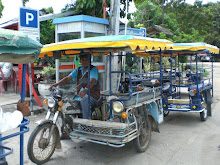Wednesday, March 4, 2009
Japanese Cruelty in SE Asia
Compared to the Japanese occupation of SE Asia during WWII, Western Colonialism was a day at the beach.
The Sumatra “Death Railway” punished not only the indigenous but POW’s from Australia, and Asia. The plan was staggering, inhumane, evil, and blatant whereas western colonial rule has not been portrayed in the same arena.
The Sumatra “Death Railway” construction is something that can be mentioned in the same breath as the Nazi concentration camps and work camps under Josef Stalin where a true violation of fundamental humanity is exhausted.
How would you categorize the “Death Railway”?
Works Used
http://www.cofepow.org.uk/pages/asia_sumatra3.html
Neher versus Heidhues
Neher versus Heidhues
Two comprehensive, concise histories of Southeast Asia; each shine in a different light.
Both authors covered similar topics ranging from the indigenous to Chinese settlement, colonialism, and the present.
Looking at Thailand; for my fancy, as one taking more interest in Thailand compared to other nations in the region, I found Neher’s coverage of recent events in every Southeast Asian nation, and the section on specific leaders more enriching.
Heidhues reports a fine chronological timeline of Thailand’s recent issues beginning with Japanese relations, the photo of a Japanese general displays the strong presence Japan had undertaken during WWII. Both agree on general facts but Neher paints a rosier picture than Heidhues. Neher even goes as far as giving seven reasons for Thailand’s recent stability, including democracy whereas Heidhues challenges the notion of democratic success in the Kingdom.
Neher does a fine, concise expose on King Bhumibol, attributing the stability of the nation to his majesty. On the flipside, Heidhues refers to him as a “figurehead.” Is this a case of fluff, propaganda, lese majeste’ fears or all of the aforementioned. Heidhues appears to have gone more on a bit of a controversial or perhaps questioning path, where Neher could be perceived as playing it safer when mentioning of King Bhumibol.
Heidhues should be credited with providing an in-depth timeline of Prime Ministers as the country adopted the position the last 80 years. What’s interesting is that both differ on acknowledging Bhumibol as a moderator; Neher is more of an advocate
Both agree that with 15 bloodless coups, and 17 changes in Constitution since 1932, it’s difficult to usher in progress but that is indicative of the region-rapid political change. Thailand is the only nation to remain independent, never being colonized. With that said, the nation is arguably one of the more steadfast states in the region. Bhumibol’s nearly 63-year rule has had a calming, stable effect on Thailand, acting as a paternal, spiritual rock of a leader.
Works Cited
Heidhues, Mary Somers. Southeast Asia, A Concise History. New York: Thames and Hudson, 2000.
Neher, Clark D. Southeast Asia Crossroads of the World. Dekalb: Center for Southeast Asian Studies, Nothern Iliinois University, 2004.
